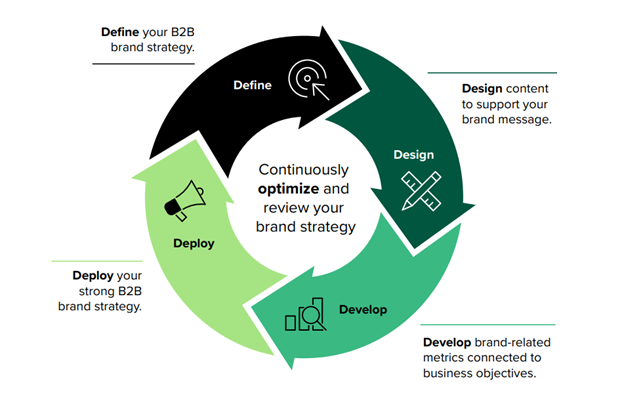Leverage The Power Of B2B Brand Strategy For Your Organization’s Growth And Revenue Opportunities
Your organization’s brand matters — a lot — but marketing often fails to demonstrate how your brand contributes to revenue and growth. Frankly, it’s difficult to measure: Translating awareness, perception, and preference into solid metrics that excite and reassure other areas of the organization about marketing’s activity is challenging. Not surprisingly, non-marketing leaders often underestimate their brand’s power.
As a result, CMOs find themselves constantly fighting for brand resources on top of an already tight budget. Another challenge is that sales and product teams often create their own messages and content without input from and coordination with marketing. This leads to inconsistent and unaligned brand messaging from various parts of the organization and a confusing and suboptimal experience for prospective clients and buyers.
This means that a CMO has to consider what really matters to B2B buyers to unlock the true potential of brand in driving revenue and growth. During the buying process, B2B buyers and purchase influencers value:
- Trust and reliability. Reputation and previous experience with a provider are both primary reasons for selecting a vendor.
- Word of mouth. B2B purchase influencers consistently identified their peers as one of the most important personal and self-guided sources of information that steered them during the discover, evaluate, commit, and engage stages of their buying journey.
Looking at the B2B brand strategy from high-growth organizations proves the real power of brand. Successful organizations have already recognized their brand’s importance and potential for driving revenue growth. Organizations that don’t prioritize brand strategy and experience risk losing business opportunities. As such, firms must build their reputation and reliability among buyers to gain a competitive advantage. High-growth organizations:
- Focus on B2B brand strategy and experience. B2B organizations that reported 20% or more in revenue growth assigned significantly more value to brand and communications growth objectives than companies that reported flat to declining revenue growth.
- Recognize — and invest in — the importance of reputation. B2B marketing decision-makers at high-growth companies plan to increase their reputation program budget significantly more than those in organizations with flat to declining revenue growth.
Now that you know what matters most to B2B buyers and what high-growth organizations have achieved, what must you now consider as a CMO? To successfully leverage the power of your organization’s brand, you must:
- Define your B2B brand strategy. Review whether it fits and supports your business needs and objectives. Reinforce a strong brand and brand experience.
- Design content that supports your brand message. Remember to design content that’s targeted toward both new buyers and existing customers to both generate net-new logos and drive loyalty and advocacy within your install base.
- Develop clear brand-related measurement and KPIs connected to revenue and your business objectives. Determine both the awareness and perception of your brand in target markets and geographies to drive demand generation. Use customer feedback, surveys, and Net Promoter Score℠ to measure your existing customer base’s loyalty and advocacy. Use these insights to continuously evolve and optimize your strategy.
- Deploy your strong B2B brand strategy. Educate your brand ambassadors across the entire organization, with an especially strong focus on customer-facing roles. Align your brand strategy internally with your product and sales organizations to ensure the delivery of consistent outward brand messaging to drive revenue and growth opportunities.
Want to learn more? Clients can access more data and research through the Forrester portal and can schedule a guidance session with Christina Schmitt. If you’re not yet a client, connect with one of our industry experts here.

